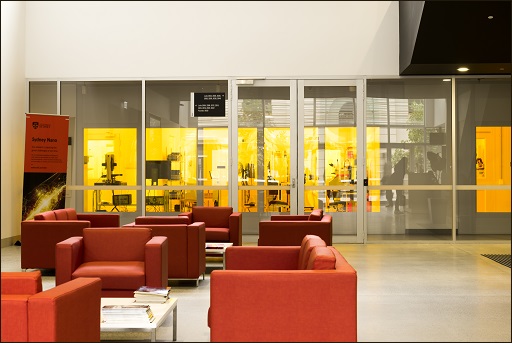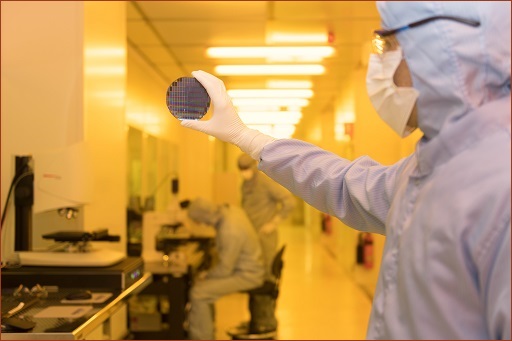First you notice the yellow lights. The chemicals inside are extremely sensitive to light, and – we are told – also extremely dangerous. Kill-you-on-contact kind of dangerous.
Our view is from the outside. It’s like an aquarium, but instead of exotic ocean creatures, we watch world-renowned scientists go about their day clad head-to-toe in special ‘clean suits’ – worn to prevent contamination.
This is the University of Sydney’s Nanoscience Hub – a $150 million node of the Australian National Fabrication Facility project.
This is where researchers use unfathomably precise tools to engineer with the universe’s most fundamental parts.
Archer Explorations invited me, alongside investors and other journalists, to visit the shared space they are using to develop their quantum computing chip: 12CQ.

The University of Sydney Nanoscience Lab has bright yellow lights. Image: Archer
Engineering a qubit
Eight years ago, Archer CEO, Dr Mohammad Choucair (who has a PhD in chemistry), developed the material that would make 12CQ possible: a carbon allotrope capable of hosting stable qubits room temperature.
Earlier this year, Archer appointed Dr Martin Fuechsle as its Manager of Quantum Technology. He has been in the field of quantum fabrication for over a decade, having worked with Professor Michelle Simmons – whose team celebrated quantum computing success in July.
Then, in August, Archer announced it had successfully positioned a qubit, thus demonstrating the feasibility of their 12CQ chip.
But it’s only one qubit and no logic gates.
“If we had built a logic gate, we would have won the Nobel Prize,” Dr Choucair said.
IBM, on the other hand, has a 53-qubit quantum computer that you can access through the cloud.
While Google sent shockwaves around the world when it made a soft claim to having achieved quantum supremacy. Its 72-qubit Bristlecone quantum processor is currently the world’s biggest quantum computer.
“We’re behind but we have different aims,” Dr Fuechsle told Information Age.
“But all the other material systems are burdened by the same drawback – which is a massive one – which is that you have to cool it down to cryogenic temperatures.”

Can you see the qubits on this wafer? Image: Archer
Quantum computers stand apart from classical computers by having access to superpositional states. That is, along with the binary on-off states that form a classical bit, a qubit (short for quantum bit) can be in a superposition of both – but if the qubit loses ‘coherence’ it also loses its unique computational power.
“The inherent issue with controlling a quantum mechanical state is that is it’s insanely perceptible to interaction with the environment,” Dr Fuechsle said.
“That can be in the form of light shining on it, or any type of heat, so you have got to really shield the qubit and decouple it from the environment.
“One fairly straightforward way to reduce this interaction with the environment is to cool everything down.”
Isolating and cooling down quantum computers – often to temperatures nearing absolute zero – means the devices are extremely large, unwieldy, and expensive.
“We are aiming to tap into the mobile market,” Dr Fuechsle said.
“We believe the future is going to be hybrid devices that are not fully quantum, but instead will be quantum and classical devices that are fused together on-board.
“And the potential for our system is that it can do this at room temperature.”

The quantum revolution doesn't look like much on the surface.
Prior to the tour, Dr Fuechsle had laid out some of his materials on a table near the mirror.
A vial of liquid, stacks of round black wafers, and a container of nine small rectangular pieces – inert, dull, easily lost in the overwhelming yellow light.
“That is our qubit,” said Dr Choucair as we crowded around to get a closer look.
“Of course, you can’t really see anything without an electron microscope.”










